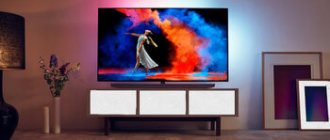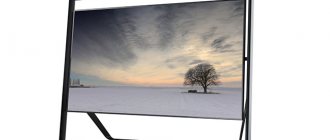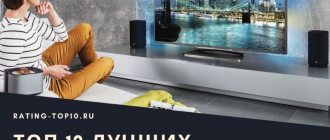Best Gaming Consoles of 2021, TOP 10 Best Gaming Headphones of 2021, Best Gaming Laptops of 2021, Best PC Games of 2021
What you will learn about:
- Low input lag is important
- High refresh rate - you'll appreciate it
- 4K Gaming TV Resolution
- HDR - why does it matter?
- What diagonal should a TV be for gaming?
- A special game mode will also come in handy
- HDR - why does it matter?
- Best gaming TVs 2020-2021
4K resolution
Revolution in resolution: Xbox One S renders all its games in 4K, thanks to surprisingly good built-in upscaling. PS4 Pro also outputs games in 4K using a combination of upscaling and in-game enhancements. The Xbox One X is so powerful that it can play games with 4K support built into the engine. Yes, you may not have 4K Xbox One and PS4 consoles. And yes, games that don't support 4K resolution will need to be upscaled on a 4K TV, so won't be completely clean. But right now, the best 4K TVs do a great job of upscaling, without significantly delaying the time it takes for the TV to render images.
HDR
Very close to 4K in the modern video world is high dynamic range (HDR) technology. It provides images with a much wider range of brightness than the standard dynamic range images we've lived with for decades. HDR attempts to provide images on screens that more closely resemble how our eyes see the real world.
Xbox One S supports HDR in games and streaming apps. The same situation applies to PS4 and PS4 Pro, and naturally the Xbox One X also offers HDR playback. Most people will say that HDR performs much better than 4K, especially on smaller screens.
The only problem is that HDR puts a lot of stress on the TV, requiring extra brightness and deeper blacks at the same time. In fact, a poorly done HDR can look worse than a decently done SDR. This is worth considering if you are thinking about buying a very cheap TV.
One of the most important elements of good HDR reproduction is brightness. Many movies and games target 1000 nits or so for bright elements, so if you have a TV with lower brightness, it won't capture the full potential of HDR. Especially in video games where the graphics can be sharper in contrasting conditions than "real life".
It's entirely possible for TVs to deliver great HDR pictures without reaching 1000 nits or higher brightness. This is especially true for, for example, OLED screens. But the darker the screen, the more difficult it will be to process image information in HDR areas beyond the screen's capabilities.
Panel types
Then you can consider additional bits and features that enhance the games. First up is the panel type: most are edge-lit LED panels, and most come with HDR as standard so will display images with acceptable color, contrast and sharpness. Those who want brighter images (for colorful games like Assassin's Creed Odyssey) should definitely consider Samsung's QLED models, which are brighter than any other panel. If contrast and true blacks are important to you, and you're a fan of games like Metro: Exodus, then you might want to look at OLED panels. There are many manufacturers, but LG screens are the best here.
If you can't afford the most expensive TVs, then look at TVs with high refresh rates and acceptable response times. The best 4K HDR TVs have input lag of around 20ms or less, mid-range models around 30ms, and slower screens respond in 40ms or more. Typically, a difference of about 15 ms between the two screens is already noticeable. Look for TVs with a gaming mode that allows for fast response speeds. If you're a really serious gamer, especially when it comes to reaction-based online games, you'll need to take care of input lag: the time it takes for a particular TV to display the image data received at its inputs. Obviously, you'll be looking for low values unless you want to get shot by an enemy your TV hasn't shown yet!
Again, manufacturers don't always provide input lag data in their specifications. We recommend TVs that have a "gaming" mode with low input lag, and all options should provide low input lag (input lag) in 4K 60 Hz mode with HDR enabled.
How to choose a 3D TV?
To begin with, accept the fact that you will have to shell out a considerable amount of money. A quality product is worth it. I urge you not to purchase consumer goods. Firstly, you will not feel any pleasure from either the purchase or the game. Low contrast means a blurry picture. Faded colors mean a boring story. Secondly, a considerable amount of money will be spent, and the service life may turn out to be very, very modest. Therefore, it is better to save up the missing money and, without being greedy, buy the best or not buy it at all.
The main points are that choosing a 3D TV comes down to choosing a TV in general. The main thing to remember is that a large diagonal, excellent contrast and a minimum screen refresh rate of 120Hz are important to us. Next is optional, but also important.
Infrared transmitter – for viewing “active” 3D. Passive technologies are good, and they, of course, have a right to life. But that's just for now. The future belongs to active 3D. Its disadvantages will disappear, and its already excellent quality will grow. This means that in order not to update your TV in a year, we immediately take normal equipment.
And since we are going to use this miracle of technology as a screen for games, we cannot do without an HDMI 1.4 connector, and ideally several, so as not to yank the cable back and forth. Well, for clarity, it’s worth taking a look at the best representative of this category.
Sound plays an important role in the game
And with the advent of games with surround sound, it becomes even more important. In fact, the Xbox One S and Xbox One X consoles even support Dolby Atmos, a state-of-the-art sound system that beams sound from above for a truly immersive soundstage experience.
This year there has been an increase in the number of TVs with truly powerful sound systems.
When you buy a TV, you should pay attention to the following points: whether the speakers are facing forward (as this will almost always give you a more direct, clear sound); rated output power; is there a dedicated bass speaker (often on the back of the TV); built-in sound panels; and the number of individual columns used.
HDMI cable for 4K
To take full advantage of HDR and 4K at 60fps, you'll need HDMI 2.0 compatible ports (on your console, media player, TV). There are cables on the market that are labeled as "4K certified" or something like that, but that's nonsense. There are only two true types of HDMI cable: standard speed and high speed. With high speed cable everything should go well.
By default you should be well supplied with inputs these days, but it's worth checking out the number of HDMI ports your TV has. More is better for gamers, especially those with multiple gaming consoles, devices, and sound systems.
Another thing to consider is the user interface - how easy is it to use? Does it switch quickly between channels or inputs, and is there voice control for the TV?
When it comes to choosing the best gaming TV, there are many factors to consider. It's likely that your TV will be used for more than just gaming, so you'll want to make sure it's right for your home in terms of size, usability, and efficiency for movies, TV, and everyday use. In addition, we are not talking about choosing the most expensive or the most luxurious: the modern range of high-quality 4K TVs allows you to buy a good gaming TV for reasonable money.
Now that the basic buying guidelines for 4K HDR gaming-ready TVs are out of the way and you're almost an audio/video expert, let's take a look at our ranking of the best gaming TVs of 2020 , taking into account the combination of price and quality.
What does the size of the TV affect?
It is clear that everyone who comes to an electronics store to buy a TV first of all pays attention to the models with the most impressive diagonal. However, when it comes to a gaming TV, it is important not to go overboard with the size.
There is a simple logic here - the larger the diagonal, the more impressive the distance to the screen should be . If you buy a 32-inch model and sit at arm's length from it... then during the game you will have to pretty much run your eyes around the entire image. And, if moving left and right does not cause much tension, then vertical jumps of the eyes will very quickly tire your brain. Dizziness and even nausea are possible!
As a rule, in order for the entire picture to fit in the player’s field of vision, you need to move 1-2 meters from the screen. Moreover, each model will have its own distances.
- The owners of Toshiba 32L4353RB (32 inches) write about a comfortable zone of 1.5 meters.
- Owners of LG 42` models, for example, the LG 42LB588V , talk about a distance of 2 meters.
- People who bought universal models with a diagonal of up to 24 inches, as a rule, play at a distance familiar to gamers of 50-70 centimeters.
Well, and, of course, the second point is resolution . Here it is worth explaining a little what it is. Resolution is the number of pixels that will fit on your screen. And an example to make it clear.
Imagine putting together a puzzle that depicts your cat in nature. But I want to collect only a cat without a background and hang it in a frame, well, a kind of manual Photoshop. All elements must be the same in shape. If the puzzle consists of 4 pieces, it will turn out quickly, but crookedly, since the background will clearly remain. When the picture is divided into 25 elements, it will take a little more time, it will turn out better, but everything will be poor, angular. And if there are 10,000 pieces, you can collect it for a year, because this woolen bastard is all monochromatic and it is difficult to distinguish light red from red, but the picture will strive for the ideal - the cat will remain, and it will be of normal shape.
The TV works the same way - the higher the resolution, the more beautiful the picture and the more powerful the processor is needed to process the pictures etc. Better resolutions are achieved on larger screens, and the larger the screen, the further you have to sit.
LG OLED C9
The best 4K TV for HDR gaming
If you have the opportunity, consider treating yourself to this amazing OLED TV. Viewing angles, color rendition, image clarity and excellent motion processing. This ultra-thin TV will make immersing yourself in great games like Forza 7 or God Of War even better.
The LG OLED C9 features the new 2nd generation α9 Intelligent Processor, which helps make the TV's HDR images brighter than previous OLED models from the South Korean firm. HDR10 mode makes compatible games look more dynamic when you have Dynamic Tone Mapping enabled. Add to this perfect blacks, responsive input lag of just 12.9ms in gaming modes at 60Hz, approximately 6ms at 120Hz, and a response time of 1ms. The LG C9 comes with G-Sync support, and supports HDMI VRR and ALLM. An adaptive sync standard supported on Xbox One X and, since a recent firmware update, also on PCs with Nvidia RTX 20-series and GTX 16-series graphics cards.
The LG OLED C9 includes 4 HDMI ports with support for the future-proof 2.1 standard, which should work well with next-gen consoles and PC graphics cards.
With excellent scaling and full compatibility with OSSC and Framemeister for retro gaming, the C9 handles low-resolution content with confidence. LG TV's webOS smart system software can also be considered the best on the market, thanks to an intuitive and responsive interface that includes easy Wiimote-style selection and fast multitasking.
You can consider the LG OLEDB9 or LG OLEDC8, which also offer excellent image quality, low input lag, but allow you to save money.
Specifications LG OLED55C9
| Diagonal size: | 55 inches |
| Permission: | 3840x2160 px |
| Response time: | 1 ms (gray to gray) |
| Vertical viewing angle: | 178° |
| Horizontal viewing angle: | 178° |
| Frame rate: | 120 Hz |
| Upscaling to 4K: | Yes |
| HDR support: | yes (HDR10 standard, Dolby Vision/HDR10 Pro) |
| Color improvement: | Yes |
| Smart TV: | Yes |
| Digital tuner: | DVB-T2 (terrestrial) DVB-C (cable) DVB-S (satellite) DVB-S2 (satellite) |
| Teletext: | Yes |
| Number of speakers: | 2 pcs |
| Subwoofer: | 2 pcs |
| Connectors: | 3xUSB LAN 4xHDMI 2.1 mini-Jack (3.5 mm) headphones, optical |
| Functions and capabilities: | AirPlay 2 Wi-Fi 5 (802.11ac) built-in browser TV recording Bluetooth v 5.0 DLNA support voice/gesture control multimedia remote control |
| VESA Wall Mount: | 300x200 mm |
pros
- HDMI 2.1 will deliver 4K at 120Hz when HDMI 2.1 source devices are released
- Very low input lag when using gaming modes
- Black frame insertion provides better motion processing
- Excellent scaling for low resolution sources
Minuses
- No option to upscale 720p or 1080p without filters
- No FreeSync support for PCs with AMD graphics cards
- DolbyVision and HDR10 are supported, but HDR10+ is not available
Samsung Q90/Q90R (QLED)
The Best Non-OLED TV for 4K HDR Gaming
The Q90R is the successor to the Samsung Q9FNA. It is a little more expensive, but the price increase is justified. The frameless design with black aluminum stand can be a luxurious addition to any living room. This is one of the few TVs that does not require external audio as the sound is excellent. Input lag is a strong point of this TV. When gaming mode is enabled with 4K HDR content, it responds in 15ms. There is also FreeSync support, which is convenient when playing on Xbox One or PC. The panel reaches 2000 nits of brightness and instantly illuminates a dark room. Thanks to full local dimming, as well as the use of 480 individual LEDs, black levels are almost as deep as OLED.
There is no color or light distortion when viewed from a central position. When viewed from an angle, a slight streak of light appears in the upper right and left corners. The screen is bright. The image clarity is one of the best among TVs. If you're willing to splurge, this is the best QLED TV you can buy this year.
Specifications Samsung QE-75Q90R
| Diagonal size: | 75 inches |
| Permission: | 3840x2160 px |
| Response time: | 1 ms (gray to gray) |
| Vertical viewing angle: | 178° |
| Horizontal viewing angle: | 178° |
| Frame rate: | 120 Hz |
| Dynamic scenes index: | 4000 fps(PQI) |
| Upscaling to 4K: | Yes |
| HDR support: | yes, Quantum HDR 2000 (HDR10 Plus standard) |
| Color improvement: | yes (Quantum Dot Color) |
| Brightness/Contrast Improvement: | yes (Contrast Enhancer) |
| Black Enhancement: | yes (Dynamic Black Equalizer) |
| Smart TV: | Yes |
| Digital tuner: | DVB-T2 (terrestrial) DVB-C (cable) DVB-S2 (satellite) |
| Teletext: | Yes |
| Picture in picture: | Yes |
| Number of speakers: | 4 things |
| Subwoofer: | 2 pcs |
| Connectors: | 3xUSB LAN 4xHDMI 2.1 optical output |
| Functions and capabilities: | AMD FreeSync AirPlay 2 Wi-Fi 5 (802.11ac) built-in browser TV recording Miracast Bluetooth DLNA support voice/gesture control multimedia remote |
| VESA Wall Mount: | 400x400 mm |
pros
- 4K 120Hz support (though only on one HDMI port)
- Excellent brightness and low input lag in gaming mode
- Good motion processing with black frame insertion
- Variable refresh rate (FreeSync) support on Xbox One and PC
- No risk of burnout
Minuses
- Black levels and viewing angles cannot be compared to OLED
- Tizen OS is intuitive, but can experience slowdowns and includes ads
- No DolbyVision support, but HDR10 and HDR10+ supported
Where and how to place the TV?
A large screen forces its owner to upgrade the existing desktop and all its components. It's a shame, but not every home will allow you to install a screen at a distance of two meters from your favorite sofa. In a typical Russian Khrushchev, this option occurs only in rare cases.
In addition, when installing such a TV, we may encounter new difficulties inherent in inexpensive TVs.
Firstly, with their excessive weight (in the mentioned Toshiba model, even the stand for the screen is too heavy).
Secondly, with poor fastenings and regulators . Often, the mount and the screen are connected by an ordinary iron tube!!! This means that you will not be able to hang your purchase at a comfortable angle in the required place.
However, most expensive and some budget models, like LG 42LB561V . In this case, impressive dimensions are combined with low weight and fine tuning of all fastenings.
Samsung Q60R
Best Mid-Range Pick for 4K HDR
The Samsung Q60R is the cheapest QLED monitor in Samsung's 2019 arsenal. While the VA panel can't match the colors, brightness, or contrast of a more expensive OLED, it still looks great with SDR and HDR content, and it handles motion very well. The Q60R is a particularly practical choice for gamers, as it comes with one of the lowest input lag ratings, around 14ms in game mode. If you're using a 120Hz TV with 1080p or 1440p resolution (which, unfortunately, only 55-inch and larger models offer), this drops to around 10ms. FreeSync variable refresh rate support is also included on larger models, which is a boon for Xbox One and PC owners.
Specifications Samsung QE-65Q60R
| Diagonal size: | 65 inches |
| Permission: | 3840x2160 px |
| Response time: | 14 ms |
| Vertical viewing angle: | 178° |
| Horizontal viewing angle: | 178° |
| Frame rate: | 60 Hz |
| Dynamic scenes index: | 3000 fps(PQI) |
| Upscaling to 4K: | Yes |
| HDR support: | Yes |
| Brightness/Contrast Improvement: | yes (Contrast Enhancer) |
| Smart TV: | Yes |
| Digital tuner: | DVB-T2 (terrestrial) DVB-C (cable) DVB-S (satellite) DVB-S2 (satellite) |
| Teletext: | Yes |
| Picture in picture: | Yes |
| Number of speakers: | 2 pcs |
| Connectors: | 2xUSB LAN 4xHDMI optical output |
| Functions and capabilities: | AMD FreeSync AirPlay 2 Wi-Fi 5 (802.11ac) built-in browser TV recording Miracast Bluetooth DLNA support voice/gesture control multimedia remote |
pros
- Incredibly low input lag for 1080p or 4K (14ms)
- Excellent motion handling with fast response time
- Good contrast (6000:1)
- Supports FreeSync and 120Hz at 1080p or 1440p
Minuses
- Mediocre viewing angles due to VA panel
- Mediocre sound quality, although soundbars are offered
- High refresh rate and FreeSync not available on 43" and 49" models
Gaming monitors or gaming TVs
In the most modern gaming monitors, input lag can range from 2 to 4 ms. Recently, televisions with a similar meaning have appeared. There may also be special computer features to improve performance, like adaptive refresh rate with Nvidia G-Sync.
The downside to gaming monitors is their higher cost per square inch. Monitors are usually smaller in size than televisions and are used at a desktop from a distance of several tens of centimeters. They have fewer input ports and do not always have speakers. It's rare for a monitor to have a remote control. If you want to play while sitting on the couch, the monitor is not for you. In this case, you can choose one of the gaming TVs described below.
Samsung RU8000 (VA)
Best value 4K TV with tons of gaming features
If you want a premium 4K TV for gaming at a fraction of the cost of OLED or QLED TVs, then Samsung's new RU8000 series is worth a look. Samsung's panels are very good across their range, and the 2021 models have made great strides in eliminating viewing angle and upscaling quality issues in non-4K images. But still, if you sit even slightly off-center, colors shift and there is no local dimming implementation. What we love about the RU8000 series is the Real Game Enhancer feature, which reduces the panel's response time to an ultra-low 6.8ms. Combined with Freesync, this panel is great for fast-paced shooters and games. Motion control is good, with the ability to insert black frames. Just keep in mind that the 49-inch version lacks a number of these features, including Real Game Enhancer, so we recommend a 55-inch model or larger if you plan to use this TV with a PC or Xbox One.
This is a 2021 model, so you get a bunch of Samsung's useful features, like a universal remote (with built-in voice control), cable management around the back of the TV, and a Universal Guide with a whole bunch of streaming services already built-in. It's good versatility. While Samsung's other standard 4K TVs are cheaper, the 8000 series is best for gaming, so it's worth spending a little more on them.
Technical characteristics of Samsung UE-65RU8000
| Diagonal size: | 65 inches |
| Permission: | 3840x2160 px |
| Response time: | 11 ms |
| Vertical viewing angle: | 178° |
| Horizontal viewing angle: | 178° |
| Frame rate: | 120 Hz |
| Dynamic scenes index: | 2500 fps(PQI) |
| Upscaling to 4K: | Yes |
| HDR support: | Yes |
| Brightness/Contrast Improvement: | yes (Contrast Enhancer) |
| Color improvement: | yes (Dynamic Crystal Color) |
| Black Enhancement: | yes (Dynamic Black Equalizer) |
| Smart TV: | Yes |
| Digital tuner: | DVB-T2 (terrestrial) DVB-C (cable) DVB-S2 (satellite) |
| Teletext: | Yes |
| Number of speakers: | 2 pcs |
| Connectors: | 2xUSB LAN 4xHDMI 2.0 optical output |
| Functions and capabilities: | AMD FreeSync AirPlay 2 Wi-Fi 5 (802.11ac) built-in browser TV recording Bluetooth DLNA support voice/gesture control multimedia remote |
| VESA Wall Mount: | 400x400 mm |
pros
- Set up for gaming
- Excellent input lag at 1080p or 4K with SDR and HDR content
- Good contrast for a VA panel (5500:1)
- Good motion control with black frame insertion
- Variable refresh rate support (FreeSync) on 55-inch and larger models
Minuses
- Poor local dimming
- Disappointing viewing angles
- Tizen OS is intuitive, but can experience slowdowns and sometimes includes ads
LG 43UN7300 (IPS)
The best small TV for gaming
When it comes to 43-inch 4K TVs, you have a lot of choices: You can consider the $500-plus Sony or get your hands on the Samsung Q60R in that size. We recommend the LG 7300, the 2021 model manages to sell itself for under $400, which is exceptional value for this powerful TV.
It comes with an IPS screen, meaning images remain great from any viewing angle, and while the 60Hz refresh rate isn't the best for movies or games, the screen is sharp. LG's panels in this budget category are excellent, and the processing power is decent. While the 7300 isn't as thin as an OLED, it's thin and neat, with finer edges than previous models. There's compatibility with Alexa voice control and Google Assistant, which, while not 100% accurate, is a pretty nice addition to LG's mediocre user interface. The sound quality is among the best for TVs in this sub-$500 price range, although we recommend supplementing the built-in speaker with headphones or a surround sound system if you're serious about audio. Overall, for $400 it's hard to find anything better.
Specifications LG 43UN7300
| Diagonal size: | 43 inches |
| Permission: | 3840x2160 px |
| Response time: | 12 ms |
| Vertical viewing angle: | 178° |
| Horizontal viewing angle: | 178° |
| Frame rate: | 60 Hz |
| Dynamic scenes index: | 120 fps(TruMotion) |
| Upscaling to 4K: | Yes |
| HDR support: | Yes |
| Color improvement: | yes (Advanced Color Enhancer) |
| Smart TV: | Yes |
| Digital tuner: | DVB-T2 (terrestrial) DVB-C (cable) DVB-S2 (satellite) |
| Teletext: | Yes |
| Number of speakers: | 2 pcs |
| Connectors: | USB LAN component composite 3xHDMI (v 2.0) optical output |
| Functions and capabilities: | Wi-Fi 5 (802.11ac) built-in browser TV recording Bluetooth v 5.0 Wi-Fi 5 Miracast DLNA support voice/gesture control multimedia remote control |
| VESA Wall Mount: | 200x200 mm |
pros
- Great quality
- Clear, colorful image
- Excellent input lag (~12ms) in game mode
- Viewing angles are better than VA TVs
- Clean and responsive WebOS Smart TV interface
Comparison table of PC TVs
| Name | Main characteristics | Price |
| OLED LG OLED77CXR 77″ (2020) | Screen diagonal - 77, screen resolution - 3840x2160 pixels, smart TV support, 16:9 screen format, LAN connection. | ₽ 382 995 |
| QLED Samsung The Frame QE75LS03TAU 75″ (2020) | 4K UHD diagonal 75 Smart TV (Tizen), Wi-Fi HDMI x4, USB x2, Bluetooth, 802.11ac, Ethernet, Miracast HDR support | ₽ 249 990 |
| Philips 70PUS6774 70″ (2020) | Screen diagonal - 70, screen resolution - 3840x2160 pixels, smart TV support, screen format 16:9. | ₽ 76 990 |











